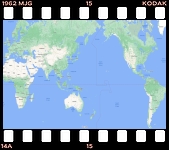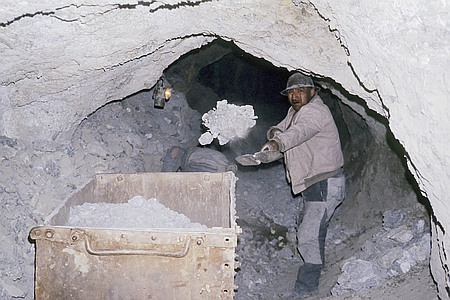The hotel seemed deserted when I woke up. Eventually someone appeared and made me some breakfast, and I headed out. Being in Potosí, the main place of interest was the “silver hill” – Cerro Rico – on the edge of town. Between the 16th and 18th centuries 80% of the world’s silver came from this one hill, and Potosí was the largest and richest city in the New World.
The nearby travel agent organised mine tours, and for the adventure I joined an Australian, 2 French girls and and a small group from Holland. A minibus, with our guide, took us up the steep zigzags. There were many different entrances all over the hill. As we gained height it was immediately obvious that the mining operation was somewhat rudimentary…
At our selected entrance there were a few small stone huts and a little stall selling mining consumables. For sale were unfiltered cigarettes, coca leaves and lime which, it was explained, were all essential for the miners to be able to tolerate working at 4400 metres altitude (14,400 feet) in the dusty, dangerous darkness. We were encouraged to buy some to give as presents to miners who we might see working in the mine. Also on sale was calcium carbide for the acetylene lamps used for lighting – there was apparently no fixed lighting in much of the mine. We were each given an acetylene lamp to carry in to the mine – these were prepared for us by some children who looked far too young to be involved with any aspect of a mining operation.
The other thing that the stall sold was sticks of dynamite – there seemed to be no electric detonators, and it seemed that the blasting technique was “light the fuse and run like hell”. We were invited to buy a stick of dynamite each – to blow up just for fun. Which we did – of course! It was probably one of the few times that many of us travellers would be able to freely purchase and detonate high explosives, without being arrested.
We poured water on the calcium carbide in the lamps to trigger the production of the flammable acetylene gas, lit them, and went inside the mine. There were strange-looking idols and shrines here and there, in alcoves cut in the side of the tunnels – the guide explained that these are important to bring the miners luck and protect them from accidents. And from what I had seen so far, there were plenty of opportunities for accidents.
If, for someone unfamiliar with mines, it was a scary experience, then for someone with an MSc in Rock Mechanics and Excavation Engineering I can report that it was even scarier! I cast a critical technical eye over the installations and quickly decided that this would be an excellent case-study in how not to engineer a mine. The guide (who was a former miner himself) didn’t exactly help, explaining that nobody really knew how much rock there was between one horizontal shaft and other horizontal shafts above and below, and he seemed unaware of the concept of rock bursts and the dangers of reduced overburden pressure with high horizontal pressure, in a horizontal shaft. The sight of a vertical pit prop that had been snapped by horizontal bowing of the side wall, confirmed that I was right to be concerned about rock bursts…
I therefore decided that by far the best option was to stop being a geotechnical engineer, and go back to being a wide-eyed tourist. We found some miners at work at both a zinc ore face and then a small silver ore face and stopped to talk to each group. They said that due to the awful conditions the life expectancy of a miner is 40 years, so one of the main functions of the miners’ cooperative is to provide a contributory pension scheme, to maintain each miner’s widow and family when he inevitably dies of silicosis…
Eventually we emerged from the depths of the hill, blinking in the bright sunlight. I had felt a little feverish in the mine and after descending to Potosí decided to have an easy afternoon at the hotel writing some postcards. The fever continued so I soon got into bed, with extra blankets, hoping to feel better the next day.
The morning (22nd January) brought a small improvement, so I checked out and went in search for some transport to Uyuni. The problem is that the road is so rough that no buses do the route. However, there are unofficial pickup trucks that go on an ad hoc basis, when there are enough people. I was told that a pickup would be going that morning, but not until “10:30-11:00”. I went on a frustrating search for some breakfast, before returning to get the pickup. But in the end it didn’t show up until after midday. Several of us piled into the back and off we went.
It was pretty cold but the scenery was beautifully wild, and someone lent me half of their blanket to keep me warm. I didn’t feel at all talkative – I still had a fever, and my insides were clearly not at all happy with something I’d eaten. The road was very rough indeed, and very slow, with too many river crossings to count – the crossings were mostly fords. I could understand why there were no buses…
Finally at 9 pm we reached Uyuni and I checked in to the Hotel Avenida which is better than I expected, and my room has a private bathroom – a good thing too, given the delicate state my guts are now in. I had a light meal, accompanied by a spirited football match on the TV, between England and Argentina. It was the Masters World Cup (for over 35’s) – famous veterans Bobby Moore and Mario Kempes were playing. Predictably, Argentina thrashed England 5 goals to 2…


Nope. No way, no how I’d go in that mine and tunnel. OR play with dynamite ?
😉 No sense of adventure…?
Malcolm, I’ve been reading your diary and pictures. Certainly quite an adventure!
Something that we probably don’t give a second thought to when we are young.
Much more caution now…
It’s well worth putting your experiences out there for all to read.
I’m about half way through, but over the next few days I’ll dip in as you go round the globe.
All the best Cliff